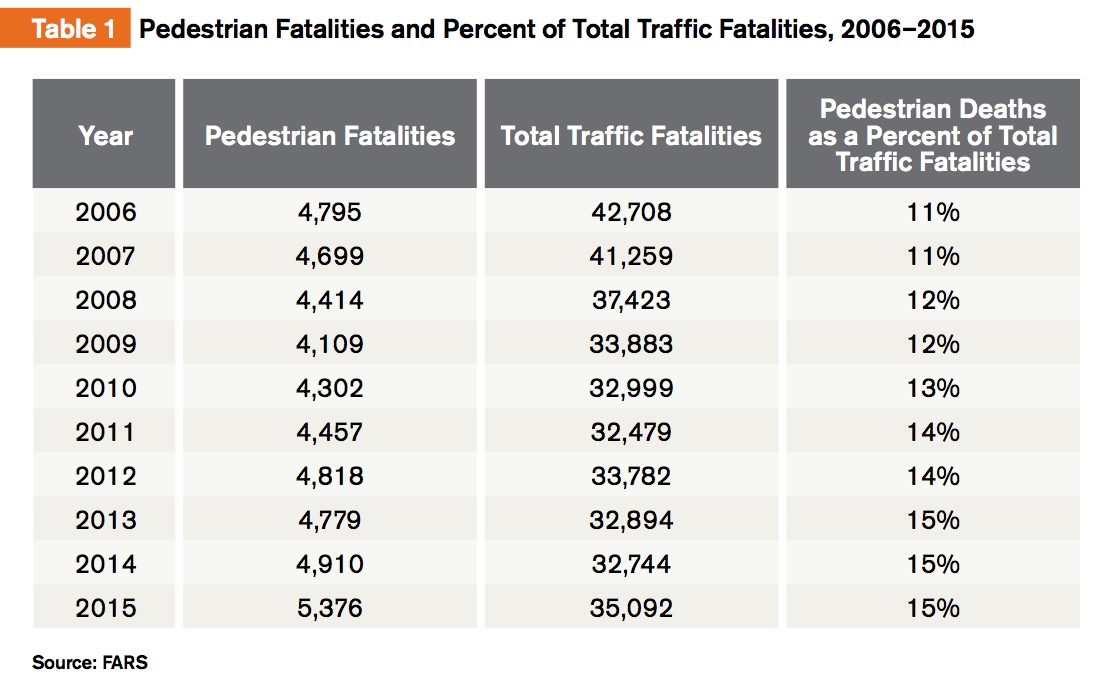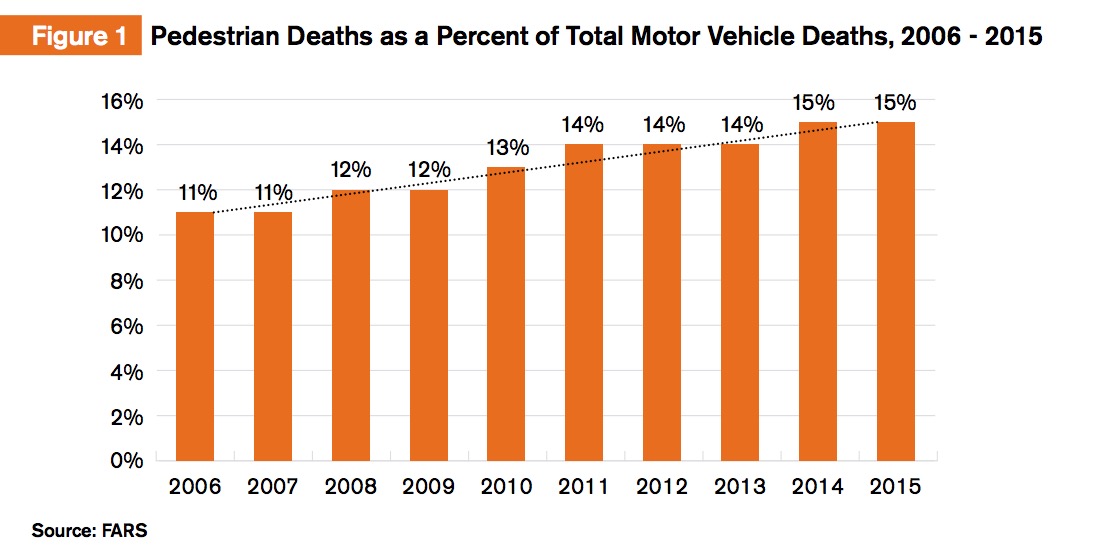GOVERNORS HIGHWAY SAFETY ASSOCIATION
Summary
The number of pedestrian fatalities in the United States (U.S.) increased 25 percent from 2010 to 2015, while at the same time, total traffic deaths increased by about six (6) percent. Pedestrians now account for the largest proportion of traffic fatalities recorded in the past 25 years. Earlier studies by the Governors Highway Safety Association (GHSA), based on preliminary data reported by State Highway Safety Offices (SHSOs), were the first to predict recent increases in pedestrian fatalities.
The present study, based on preliminary data from all states and the District of Columbia (DC) for the first six months of 2016, found an increase of seven percent in the reported number of fatalities compared with the first six months of 2015. More than twice as many states had increases (34) than had decreases (15 plus DC) compared with 2015.
After adjusting for anticipated underreporting in the preliminary state data, GHSA estimates the number of pedestrians killed in 2016 increased by 11 percent compared with 2015. This was the largest annual increase in both the number and percentage of pedestrian fatalities in the 40 years that national records have been kept, with the second largest increase occurring in 2015. In addition, pedestrian deaths as a percent of total motor vehicle crash deaths have increased steadily, from 11 percent in 2006 to 15 percent in 2015.
The number of nationwide pedestrian fatalities for all of 2016 was estimated based on preliminary data provided by State Highway Safety Offices (SHSOs) for the first six months of 2016, taking into account historic data regarding the relative proportions of pedestrian fatalities that occurred in the first and second halves of the year. About 6,000 pedestrian fatalities are estimated to have occurred in 2016, which could make 2016 the first year in more than two decades with more than 6,000 pedestrian deaths.
GHSA’s latest survey indicates the following:
- States reported a range of changes in the number of pedestrian fatalities in the first half of 2016 compared with the same period in 2015:
34 states had increases; 15 states and DC had decreases in pedestrian fatalities; and one state – Maine − remained the same. - States differ widely in fatality numbers: The number of pedestrian deaths for the first half of 2016 ranged from one in Wyoming to 359 in California; five states (California, Florida, Georgia, Texas, and New York) each had more than 100 pedestrian deaths, while 10 states (Alaska, Idaho, Maine, Montana, Nebraska, New Hampshire, North Dakota, Rhode Island, South Dakota, and Vermont) and DC each had fewer than 10; four states (California, Florida, Texas, and New York) accounted for 42 percent of all pedestrian deaths; and Delaware, Florida, and Arizona, respectively, had the highest rates of pedestrian deaths per resident population, while North Dakota, South Dakota, and Wyoming had the lowest.
- States use various combinations of engineering, enforcement, and education countermeasures to address pedestrian safety, including targeted enforcement in conjunction with public outreach and education.
Many factors contribute to changes in the number of pedestrian fatalities, including economic conditions, demographics, weather, fuel prices, vehicle miles traveled, and the amount of time people spend walking. Travel monitoring data published by the Federal Highway Administration (FHWA) indicate that motor vehicle travel on all roads and streets increased 3.3% (50.5 billion vehicle miles) for the first half of 2016 as compared with the same period in 2015.1 A more recent contributing factor may be the rapidly growing use of smart phones to access wireless data while walking and driving, which can be a significant source of distraction for both pedestrians and motorists.
Introduction and Background
- Walking is the oldest, most basic, and arguably the most beneficial form of human transportation. Walking provides many important personal and societal benefits:
- Health: The Centers for Disease Control and Prevention notes that “walking is a great way to get the physical activity needed to obtain health benefits.” Along with the important benefit of social engagement, walking can reduce the risk of obesity, heart disease, diabetes, and stroke.
- Transportation: The 2009 National Household Travel Survey found that 28 percent of trips are less than one mile in length, and 40 percent are less than two miles in length, representing 15- 30 minute walks. Moving from a vehicle to the sidewalk can help reduce congestion.
- Economic: AAA estimated in 2016 that the cost of operating a car for one year is approximately $8,558,4 while walking is free.
- Environmental: According to the U.S. Environmental Protection Agency, motor vehicles are responsible for more than one-half of nitrogen oxide and toxic air pollutant emissions, and one-half of smog-forming volatile organic compounds.5 Walking, on the other hand, does not negatively impact the environment.
- Transit: Walking is intrinsically linked with public transit, which provides a vital alternative to travel by private automobile. Many transit users do not drive cars, including children, older adults, people with disabilities, and the economically disadvantaged. Safe access to transit, including appropriate design and placement of bus stops, is important.
The good news is walking is becoming an increasingly popular mode of transportation. A 2015 report by the Government Accountability Office (GAO) noted that nearly one million more people reported walking or biking to work in 2013 than in 2005.
According to the U.S. Census Bureau’s American Community Survey (ACS), in 2015 an estimated 4.1 million Americans reported walking to work in the past week. This number has risen about 4 percent since 2006, when an estimated 3.9 million people reported their primary method of commuting to work in the past week was walking. The percentage of Americans who walk to work may be higher than reported by the ACS, which asks respondents to choose their primary means of travel to work in the previous week. By allowing respondents to select only a single transportation mode, ACS undercounts trips in which more than one mode is used. In addition, ACS does not count trips other than traveling to work, which therefore omits walking trips associated with school, shopping, social engagement, and exercise.
Unfortunately, pedestrians represent a growing percentage of total traffic fatalities and injuries. For example, pedestrian fatalities comprised 11 percent of all traffic deaths nationwide in 2006 and 2007, but 15 percent in 2014 and 2015, as detailed below.
Table 1 and Figures 1 through 5 provide analysis of the most recent pedestrian fatality data from the Fatality Analysis Reporting System (FARS) as published by the National Highway Traffic Safety Administration (NHTSA). Although the number of pedestrian fatalities has fluctuated within a relatively narrow range over the past 10 years (4,795 in 2006 to 5,376 in 2015), with no consistent pattern of annual increases or decreases, pedestrian fatalities accounted for a steadily increasing percentage of total traffic fatalities.
During this ten year period, pedestrian deaths as a percentage of total motor vehicle crash deaths increased from 11 percent to 15 percent (Figure 1). 2015 was the second consecutive year in which pedestrians accounted for 15 percent of total traffic fatalities. Prior to this, it had been 25 years (1990) since such a large proportion of traffic deaths involved pedestrians. In addition to the role that increased walking may play in the increasing number of pedestrian fatalities as a proportion of total traffic deaths, another factor may be the larger and more consistent declines in occupant fatalities, attributed in part to steady enhancements in vehicle crashworthiness and crash avoidance technology. By contrast, pedestrians remain just as susceptible to sustaining serious or fatal injuries when struck by a motor vehicle.
Download full version (PDF): Pedestrian Traffic Fatalities by State
About the Governors Highway Safety Association
www.ghsa.org
GHSA is a 501(c)(3) nonprofit representing the state and territorial highway safety offices that implement federal grant programs to address behavioral highway safety issues. GHSA has two tiers of membership: its core State Highway Safety Office (SHSO) Members and Associate Members.
Tags: GHSA, Governors Highway Safety Association, Pedestrian, Public Health, safety, Walking








 RSS Feed
RSS Feed